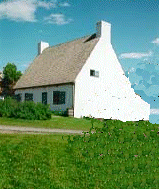When Giovanni Verrazanno, Italian navigator in the employ of Francis the 1st, explored the Atlantic coast of north America (from Georgia to Newfoundland) in 1524, he gave the region the name of New-France. 10 years later, Jacques Cartier discovered Canada and sailed up the Saint-Laurence as far as Mount Royal (Montréal). In 1608, Samuel de Champlain founded Québec and launched a vast campaign of colonization of this occidental land.The first settlers were Normans. They left from the ports of Honfleur and Touques as early as the first years of the XVIIth century. In total, 341 Normans left their native land between 1600 and 1700. They represent a quarter of all the settlers.
Two Touques families especially participated in the colonization of French Canada. The Bellenger and the De Rainville families.
The first settler from Touques is certainly François BELLENGER (1612-1687) who disembarked in Canada in the spring of 1634. He got married on the 12th of July of 1637 at Québec with Marie Guyon. The wedding contract is still visible at the Québec Seminary.
Nicolas BELLANGER (1632-1682), another native of Touques, (without known relations with the former) came to Beauport in 1655. He is only 19 years old. His occupation is that of cod fisherman. He married, on the 11th of July 1660, Marie De Rainville. They had 12 children and became known as the biggest Norman family in Canada. Today the Girardin House (on the other side of the street where Nicolas lived), is still visible in the historical site at 600 Avenue Royale in Beauport.
The De Rainville family is generally associated with the Bellenger family. De Rainvilles came from Touques to Canada under the impulse of Paul De Rainville in the years 1640. Today, 200 families bearing the name Rainville have been identified in the sole province of Québec (the particle of nobility, De, has disappeared).
Finally, this section on the people of Touques from overseas cannot be closed without mentioning the name of Pierre Magnan. This man arrived in Canada in 1617. He cannot be taken for a settler because he left France hastily. And it is because he killed a man with a stick! This dark affair did not prevent him from obtaining the trust of Champlain. In 1627, the latter gave him the task of negotiating peace with the Iroquois. On the 24th of July, Pierre Magnan left without knowing if he would ever return from his expedition ! A month later, Champlain learned of the murder of his diplomat. It was told that the Touquois was tortured until death and that his remains were eaten by his murderers. the irony of destiny is that the exile to New-France did not save the life of Pierre MAGNAN !


It is only on September 26th 1660, in a document written by Jacques Gourdeau, that it is learned that Nicolas had a nickname. However it seems that this nickname was rarely utilized in reference to Nicolas. This nickname nevertheless is often referred to in the official reports of the Council of his Majesty. In one of the reports it is learned that Pierre Lefebvre, Léonard Leblanc and himself were blamed for fishing in non reclaimed and uninhabited places off the coast of Lauzon, contrary to the orders which allowed the catch of fish in the limits of the seigneury.
In 1669, Nicolas and the other residents of Fargy are sentenced to reduce
their land by one acre, to pay their back rent for their property
qualification (cens) and current rent while at the same time clearing the
ground for the rest of the community on the penalty of losing all their
rights. Nicolas Catherine appears in a few occasions before the Québec "Prévôté".